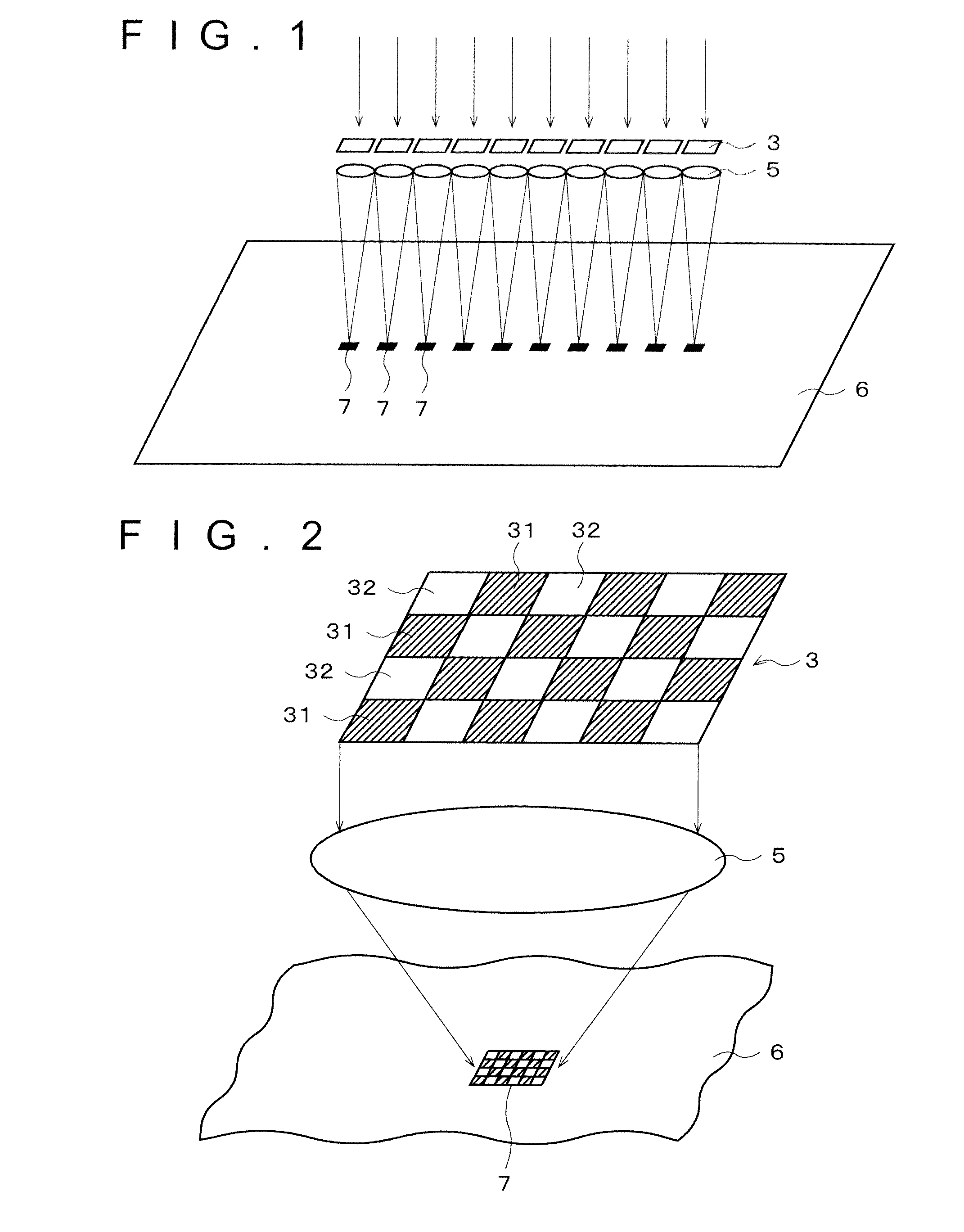Device and method for forming low-temperature polysilicon film
a polysilicon film, low-temperature technology, applied in the direction of photomechanical treatment originals, manufacturing tools, instruments, etc., can solve the problems of low charge mobility in the channel area, inability to use the direct forming of polycrystalline silicon films, and inability to use peripheral drive circuits that require high-speed overwriting to drive transistors. the effect of increasing the size of the crystal grains
- Summary
- Abstract
- Description
- Claims
- Application Information
AI Technical Summary
Benefits of technology
Problems solved by technology
Method used
Image
Examples
embodiment 1
[0037]In Embodiment 1, the light-blocking areas 31 and transmission areas 32 of the mask 4 are not limited to being of rectangular shape; they can be circular or any of a variety of other shapes. Furthermore, the approach adopted in the embodiment described above was that no mask be used in step 2 besides the light-blocking areas for defining the channel areas, but it is possible to use a mask in step 2 as well, and make the parts used as light-blocking areas in step 1 into transmission areas, and the parts used as transmission areas in step 1 into light-blocking areas. The laser light is directed only on the parts of the a-Si:H film that remain amorphous in step 1, and these parts are annealed. Furthermore, in such an instance, it is permissible to make the transmission areas in step 2 smaller than the light-blocking areas of step 1, and provide a gap between the laser light irradiation areas in step 1 and the laser light irradiation areas in step 2. This will make it possible to p...
embodiment 2
[0039]There shall now be described a method for forming a low-temperature polysilicon film using the forming device of Embodiment 2. First, in step 1, laser light is directed, using the microlenses 5, on the planned channel-area-formation areas 7 of the object of irradiation 6, using the mask 8. An irradiation pattern where areas irradiated by the laser light in a spot-shaped configuration are interspersed at equidistant intervals is obtained in the planned area 7. The areas where the laser light is directed in a spot-shaped configuration is where the a-Si:H film melts and solidifies to yield polycrystallized polysilicon.
[0040]Next, the mask 8 is removed and the entirety of the planned area 7 is irradiated with laser light. With the spot-shaped areas polycrystallized in step 1 serving as seeds, crystallization occurs and the entirety of the planned area 7 becomes a polysilicon film. In this case, the seeds for crystallization in the resulting polysilicon film are the already-polycry...
embodiment 3
[0043 of the present invention will now be described with reference to FIG. 5. The mask 9 in FIG. 5 is configured by cutting out from a light-blocking member 91 a plurality of rectangular holes at a prescribed relative spacing, the light-blocking member 91 formed using a material that blocks laser light. A plurality of transmission areas 92 comprising the plurality of rectangular holes is arranged two-dimensionally. The transmission areas 92 are surrounded by light-blocking areas comprising the light-blocking member 91, and are partitioned by the light-blocking areas.
[0044]There shall now be described a method for forming a low-temperature polysilicon film using the forming device of Embodiment 3. First, in step 1, laser light is directed via the microlens 5 on the planned channel-area-formation area of the object of irradiation 6 using the mask 9. As with Embodiment 1, only the laser light that passes through the transmission areas 92 of the mask 9 is directed onto the amorphous si...
PUM
| Property | Measurement | Unit |
|---|---|---|
| softening point | aaaaa | aaaaa |
| softening point | aaaaa | aaaaa |
| wavelength | aaaaa | aaaaa |
Abstract
Description
Claims
Application Information
 Login to View More
Login to View More - R&D
- Intellectual Property
- Life Sciences
- Materials
- Tech Scout
- Unparalleled Data Quality
- Higher Quality Content
- 60% Fewer Hallucinations
Browse by: Latest US Patents, China's latest patents, Technical Efficacy Thesaurus, Application Domain, Technology Topic, Popular Technical Reports.
© 2025 PatSnap. All rights reserved.Legal|Privacy policy|Modern Slavery Act Transparency Statement|Sitemap|About US| Contact US: help@patsnap.com



